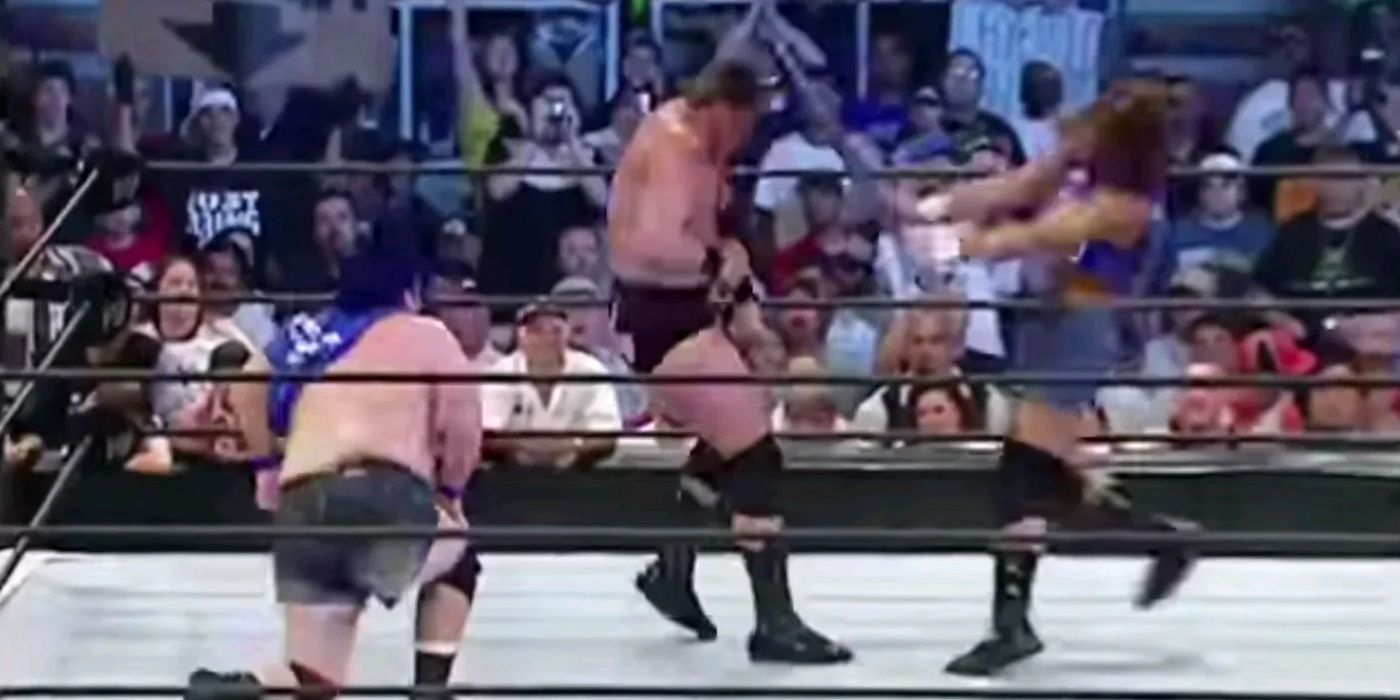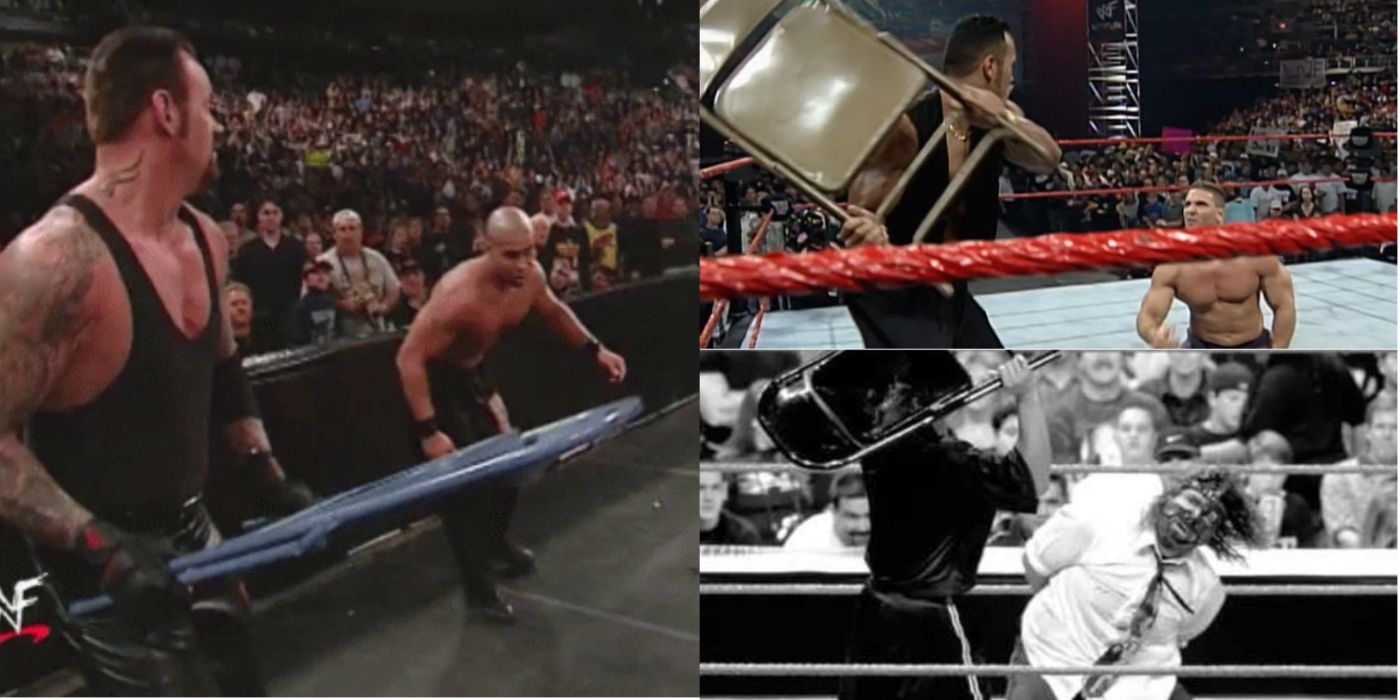The History of Chair Shots in WWE
The steel chair, a seemingly innocuous object, has become a staple of WWE’s violent spectacle, symbolizing brutality and the unforgiving nature of professional wrestling. Its use has evolved over time, reflecting changes in audience tastes, wrestling styles, and the overall presentation of the product. From infrequent, impactful moments to more frequent, sometimes overused spots, the chair shot holds a unique place in WWE history.
A Chronological Overview of Memorable Chair Shots
The following table details some of the most memorable chair shots in WWE history, highlighting the wrestlers involved, the context of the matches, and the impact of the shots themselves. This is not an exhaustive list, but rather a selection of significant examples showcasing the evolution of the chair shot’s use.
| Year | Wrestler(s) Involved | Match | Description of the Shot |
|---|---|---|---|
| 1998 | The Rock vs. Mankind | King of the Ring | Mankind endured a brutal assault, culminating in multiple chair shots to the head, showcasing the extreme violence that would become a hallmark of the Attitude Era. |
| 1999 | Triple H vs. Cactus Jack | Hell in a Cell | A legendary match filled with extreme violence, including numerous chair shots that highlighted the brutality of the Hell in a Cell environment and the performers’ commitment to the hardcore style. |
| 2000 | Mick Foley vs. The Undertaker | Various Matches | Foley’s career was defined by his willingness to take chair shots, often to the head, further cementing his hardcore legend status. |
| 2005 | Edge vs. Matt Hardy | Unforgiven | Edge’s chair shot to Hardy’s head, setting up a significant storyline turn and further establishing Edge as a ruthless heel. |
| 2011 | CM Punk vs. John Cena | Money in the Bank | A pivotal moment in Punk’s reign as champion, where chair shots were used to add to the intensity and highlight the stakes of the match. |
The Evolution of Chair Shot Usage in WWE Storylines
Initially, chair shots were infrequent, impactful moments used sparingly to heighten the drama of a match. They were often reserved for major pay-per-view events and significant storylines. The Attitude Era saw a marked increase in the frequency of chair shots, reflecting the more extreme and violent nature of the programming at the time. This era, however, also saw a shift towards more creative and less realistic chair shots, with a greater emphasis on storytelling and spectacle. More recently, there’s been a trend toward reducing the frequency and intensity of chair shots to the head, reflecting concerns about the potential long-term health consequences for wrestlers.
The Cultural Impact of Specific Chair Shots
Chair shots have often become iconic moments in WWE history, shaping storylines and influencing the way audiences perceive wrestlers and matches. The Rock vs. Mankind King of the Ring match, for example, is still discussed today as a testament to Mankind’s toughness and the extreme nature of the Attitude Era. Similarly, Triple H vs. Cactus Jack’s Hell in a Cell match is remembered for its relentless brutality, partly due to the numerous chair shots used. These moments resonated with audiences because they pushed the boundaries of what was considered acceptable in professional wrestling, creating a sense of danger and excitement. The cultural impact of these chair shots extends beyond individual matches; they helped define eras and establish certain wrestlers as legends.
The Controversy Surrounding Chair Shots

The use of chair shots in professional wrestling, while a staple of intense storytelling for decades, has always been a source of significant controversy. The inherent danger of the move, coupled with evolving societal attitudes towards violence and performer safety, has fueled ongoing debate about its ethical implications and long-term effects on wrestlers’ health. This section will examine the various perspectives on this contentious aspect of WWE’s history.
The ethical concerns surrounding chair shots stem primarily from the potential for serious injury. While performers are trained professionals, the unpredictable nature of live performance and the inherent risk involved in high-impact maneuvers like chair shots cannot be entirely eliminated.
Potential Injuries from Chair Shots
The potential for injury from chair shots is substantial, ranging from relatively minor to career-ending. The impact force, even when mitigated by technique, can cause a wide range of problems.
- Concussions: Repeated blows to the head, even with protective measures, significantly increase the risk of traumatic brain injury and long-term neurological issues.
- Broken Bones: The force of a chair shot can easily fracture bones in the skull, face, ribs, or spine.
- Lacerations and Bruises: Open wounds and extensive bruising are common, potentially leading to infection or prolonged healing times.
- Neck and Spinal Injuries: Impacts to the neck and upper back carry a high risk of whiplash, herniated discs, or even paralysis.
- Internal Injuries: The impact can cause internal bleeding or organ damage, often undetectable immediately.
Reactions to Chair Shots Throughout WWE History, Wwe best chair shots
Reactions to chair shots have evolved considerably over time. Early WWE audiences often cheered wildly for these high-impact spots, viewing them as a demonstration of brutality and athleticism. Wrestlers, for their part, often embraced the chair shot as a signature move, associating it with their persona and intensity. Commentators, reflecting the prevailing sentiment, generally portrayed chair shots as thrilling and dramatic moments. However, as awareness of the potential long-term health consequences increased, the narrative shifted. Modern audiences show a more mixed reaction, with some still enjoying the spectacle while others express concern for the wrestlers’ well-being. Many wrestlers now actively seek to minimize the risk, utilizing protective gear and modified techniques. Commentators, too, have become more cautious in their delivery, often highlighting the risk involved rather than simply glorifying the violence.
Alternative Methods for Portraying Intense Violence
The WWE could explore alternative methods of portraying intense violence without resorting to chair shots. One approach would be to focus on enhanced storytelling and character development, building suspense and drama through narrative techniques rather than solely relying on physical brutality. For example, a prolonged and suspenseful storyline leading to a match could generate just as much, if not more, audience engagement than a single chair shot. Innovative camera angles, editing techniques, and sound effects could also heighten the perceived intensity of the action. Furthermore, the utilization of more sophisticated and less overtly dangerous weapons, such as kendo sticks or steel steps, could create a visually impactful experience while minimizing the risk of severe injury. The strategic use of slow-motion replays could also emphasize the impact of strikes without requiring the actual use of high-impact moves. A scenario involving a protracted struggle between two rivals, culminating in a series of calculated, less dangerous maneuvers that build to a dramatic and satisfying conclusion, could demonstrate intense violence without the risk of chair shots.
The Legacy and Future of Chair Shots in WWE: Wwe Best Chair Shots

The evolution of chair shots in WWE reflects a broader shift in professional wrestling towards prioritizing performer safety. While iconic moments featuring the weapon remain a part of the company’s history, the frequency and execution of these spots have demonstrably changed over the years, mirroring a growing awareness of the potential long-term consequences of high-impact maneuvers. This evolution, however, is not solely confined to WWE; a comparative analysis with other wrestling organizations reveals a similar trend across the industry.
WWE’s Adapted Approach to High-Impact Moves
WWE has implemented several strategies to mitigate the risk associated with chair shots and other high-impact moves. These include a greater emphasis on protective measures, such as improved padding and ringside safety protocols. Furthermore, the execution of chair shots themselves has been modified. Instead of the full-force, repeated shots common in earlier eras, modern chair shots often involve a more controlled impact, with a focus on dramatic effect rather than pure brutality. The increased use of camera angles and editing techniques also contributes to the perception of impact without necessarily requiring the same level of physical force. For example, a well-placed shot to the back might be shown in slow motion, emphasizing the force, while the actual physical contact is less severe than it appears. This allows for the preservation of the visual impact of the move while reducing the risk of injury.
Comparative Analysis of Chair Shot Usage
Comparing WWE’s approach to chair shots with other major professional wrestling organizations reveals a widespread trend toward safer practices. While some promotions may still feature chair shots more frequently or with less apparent emphasis on safety precautions, the overall industry-wide shift towards protecting performers is undeniable. Organizations like AEW, for example, while featuring high-impact wrestling, also exhibit a growing awareness of performer safety, demonstrated by a greater emphasis on controlled movements and well-rehearsed sequences, even for high-impact spots. This isn’t to say that high-impact moves are completely absent, but the approach has shifted to prioritizing performer health. The differences are subtle but significant, showcasing a common trend across the industry toward minimizing the risk of long-term injury.
Observed Decline in Chair Shot Frequency
Analysis indicates a decline in the use of chair shots in WWE, primarily due to increased awareness of safety concerns and the potential for long-term health consequences for performers. This is reflected in both the frequency of chair shots and the manner in which they are performed.
